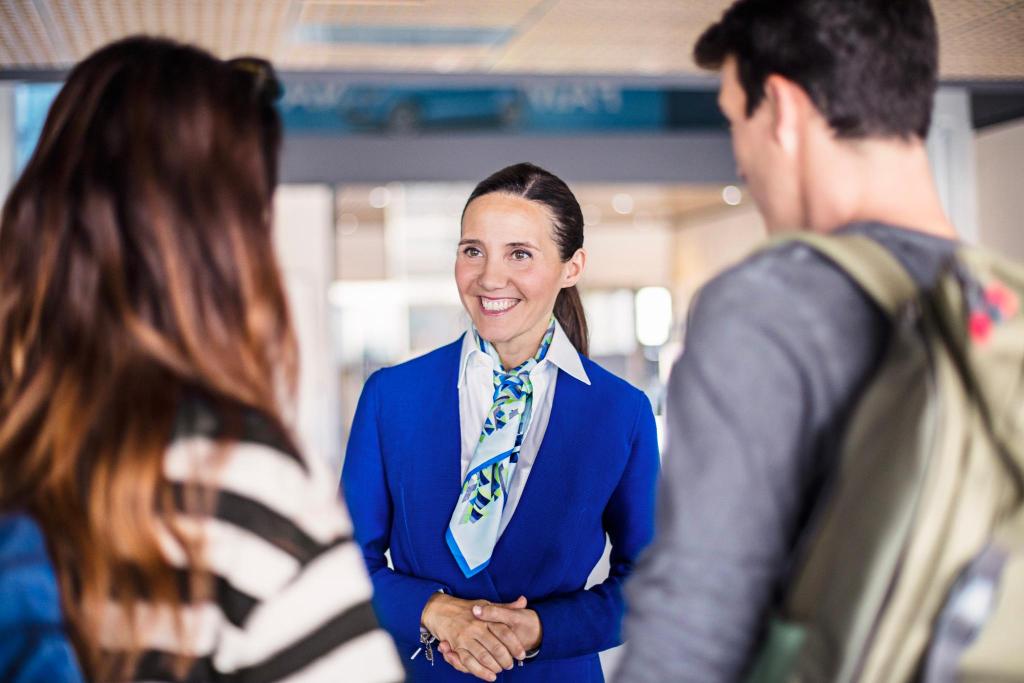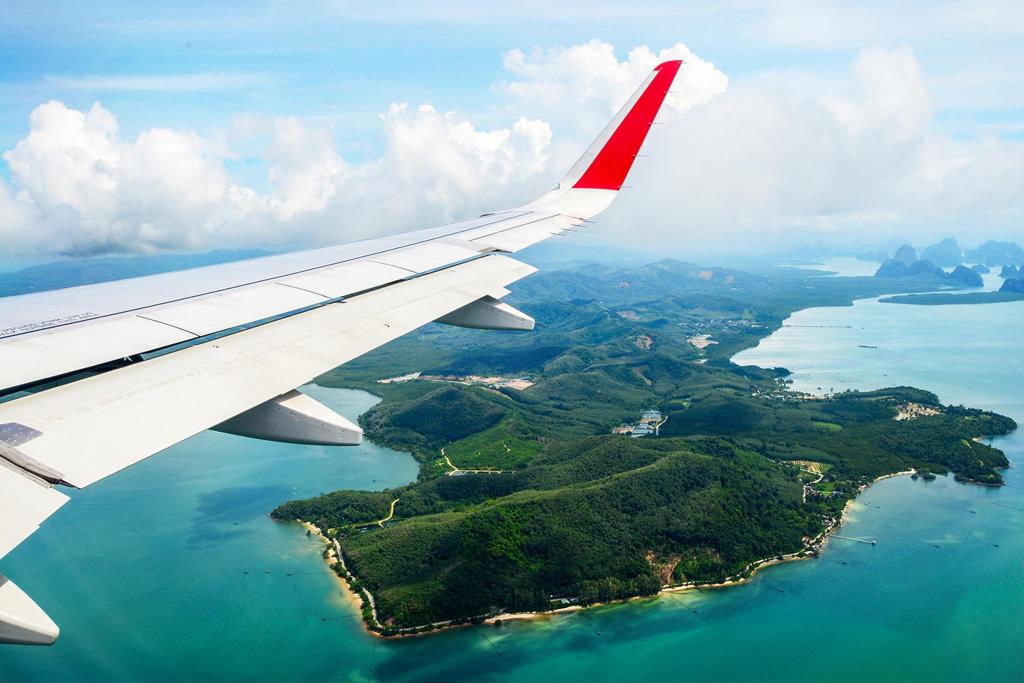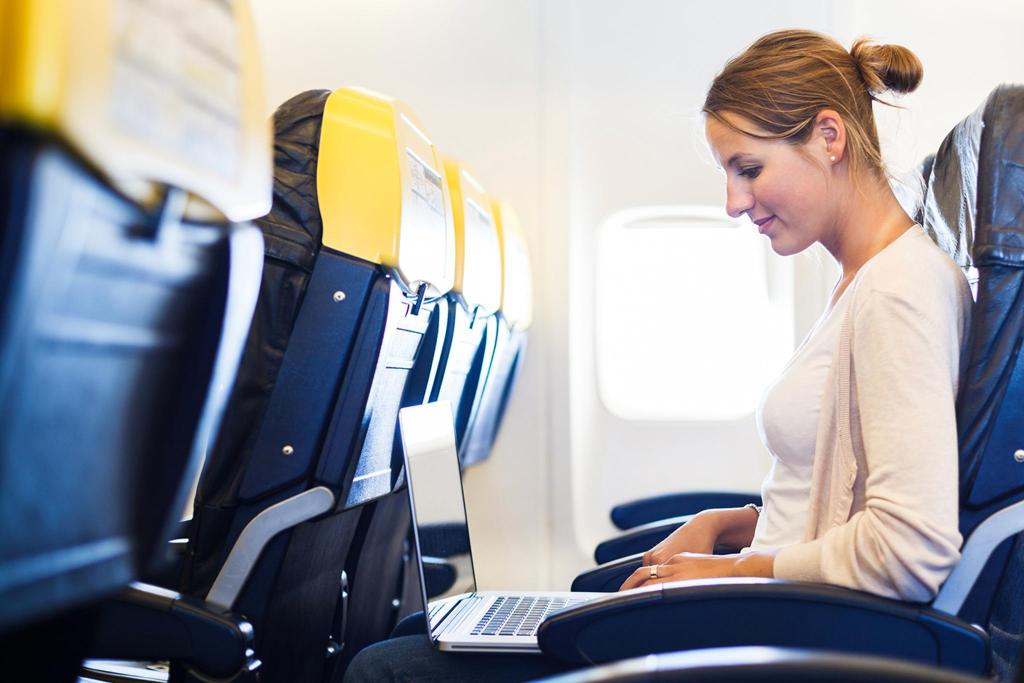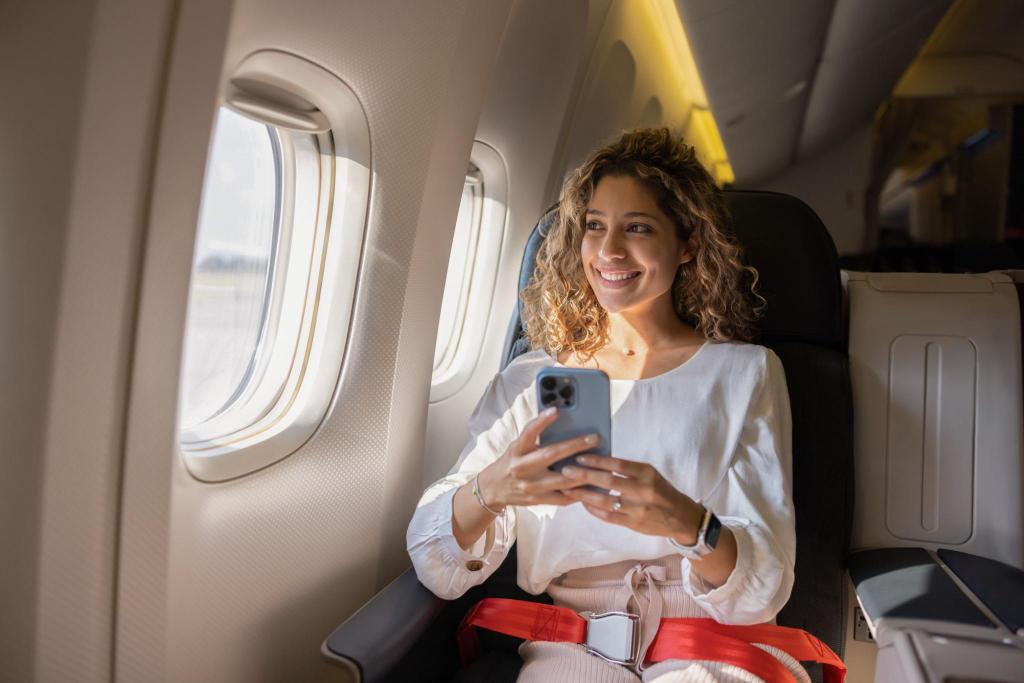
The Complete Guide to Airplane WiFi: How to Stay Connected While Flying
Ever wondered why you’re able to scroll social media at 35,000 feet? Airplane WiFi uses specialized systems to ensure you stay connected through your flight.
Do airplanes have WiFi?
Most modern commercial aircraft now offer WiFi connectivity. While not every flight is equipped with internet access, it's becoming increasingly common, especially on longer routes and newer aircraft. The availability of WiFi can vary depending on the airline, route and aircraft type.
Many airlines are actively expanding their WiFi coverage, with some carriers already offering internet access across their entire fleet. However, it's important to note that connectivity might not be available throughout the entire flight, particularly when crossing remote areas or oceans.
Most airlines allow you to check if Wi-Fi will be available on your specific route before booking your flight. This information is typically displayed during the booking process or can be found by checking your flight details after purchase.
Which airlines have WiFi?
The availability of in-flight WiFi varies by airline and route. Here's a comprehensive breakdown of what major airlines currently offer:
North American airlines:
- Delta: Available on most domestic and international flights, with plans for free WiFi now available across most of their fleet
- United: Available on most mainline aircraft with expanding coverage on regional jets. Cost varies by the length of the flight and free or reduced wifi is available through certain partners
- American Airlines: Available on nearly all domestic flights and international wide-body aircraft. Monthly and annual plans are available for those who fly more frequently
- JetBlue: Free WiFi (cheekily called Fly-Fi) on all flights across the continental US. Some international routes may also have coverage
- Southwest: Available on most routes and has recently been updated
European airlines:
- British Airways: Available on most long-haul flights with plans to expand to short-haul
- Lufthansa: Available on most intercontinental routes and select European flights
- Air France: Available on most long-haul and select short-haul flights
- KLM: Available on most intercontinental flights
- Norwegian: Available on most Boeing 787 Dreamliner flights
Asian Airlines:
- Singapore Airlines: Available on most aircraft with high-speed capabilities
- Emirates: Available on most flights with free messaging plans
- Qatar Airways: Available on select aircraft with Super Wi-Fi service
- ANA: Available on international routes
- Japan Airlines: Available on select international and domestic routes
How much does airplane WiFi cost?
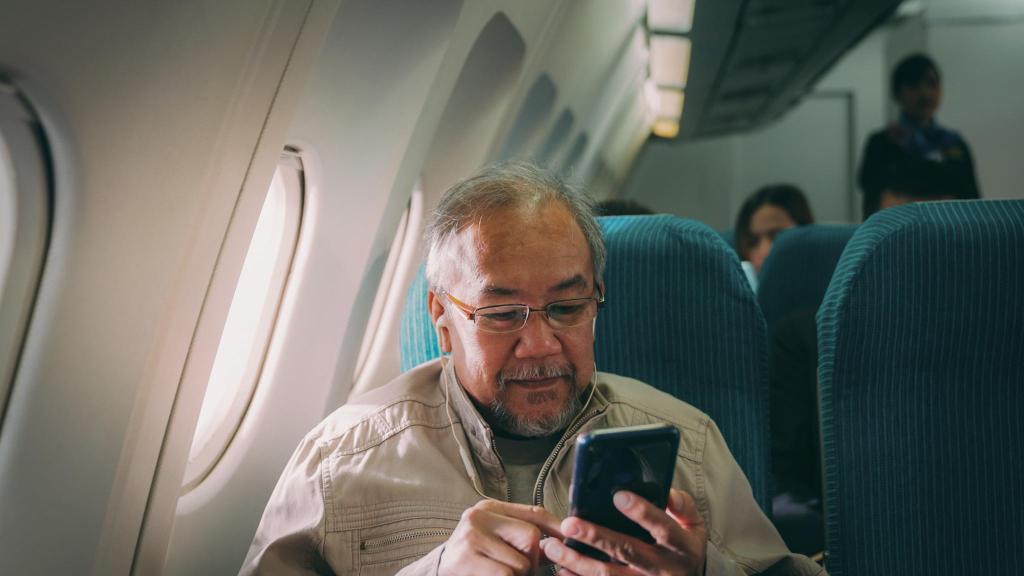
In-flight WiFi pricing varies significantly depending on the airline and the type of pass you choose. Here's a detailed breakdown of typical costs and options:
Short-haul flights (under three hours):
- Basic browsing: $8-15
- Full-flight access: $10-20
- Messaging only: often free or $2-5
Long-haul flights (over three hours):
- Basic access: $20-30
- Full-flight premium access: $25-40
- 24-hour passes: $30-50
Subscription options:
- Monthly airline-specific passes: $40-60
- Annual passes: $400-600
- Alliance-wide passes: Available through some airline groupings
Many airlines offer different pricing tiers based on usage:
- Basic browsing (email and messaging)
- Standard browsing (social media and basic websites)
- Premium access (streaming capability)
- Time-based passes (one hour, three hours or full flight)
How to save money on airplane WiFi
Some airlines allow you to book your Wi-Fi pass in advance through the airline's website or app, where prices can be 20-40% higher when purchased during the flight. Some credit cards, cell phone providers and airline loyalty programs also offer discounted or complimentary WiFi access. For example, T-Mobile customers can access complimentary WiFi on United flights. You can also consider booking an airline like JetBlue that offers free in-air WiFi.
Is it safe to use WiFi on a plane?
According to aviation experts, using WiFi on an airplane is completely safe. Modern aircraft are designed with WiFi systems that operate independently from critical flight systems. These networks use specialized equipment that's been thoroughly tested and certified by aviation authorities.
When using airplane WiFi, you should follow these basic security practices:
- Use a VPN for sensitive information
- Avoid accessing banking websites
- Be cautious with personal information
- Ensure websites are secure (look for HTTPS)
- Log out of all accounts after use
- Disable auto-connect features
- Use strong passwords if creating an account
How fast is airplane WiFi?
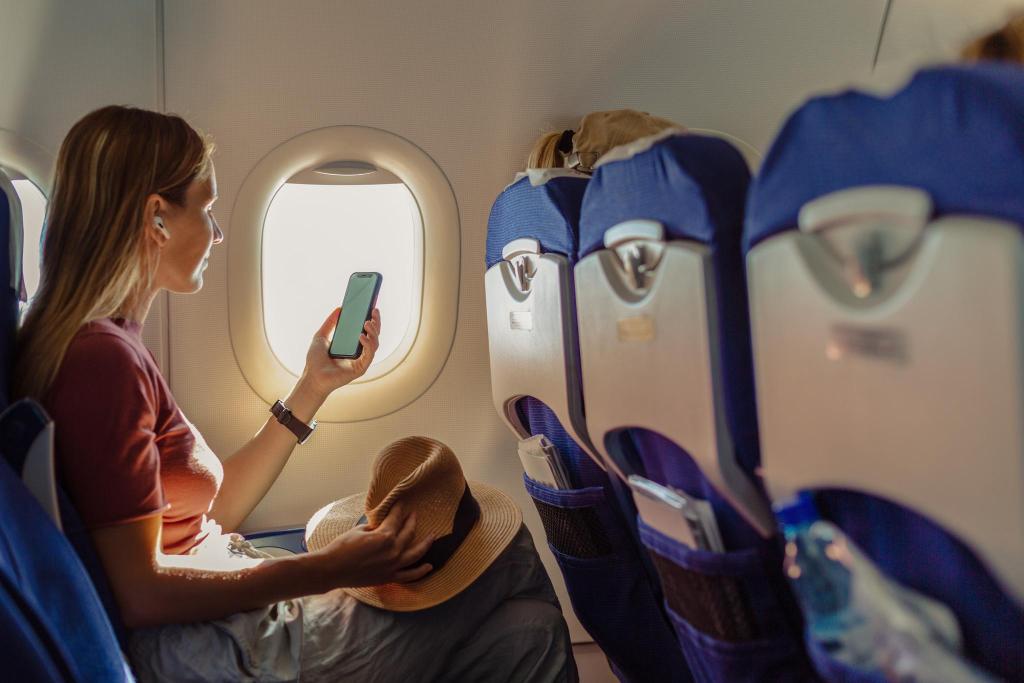
Airplane WiFi speeds have improved significantly in recent years, but they still vary based on several factors. Here's what you can typically expect:
Ground-based systems:
- Average speeds: 10-15 Mbps
- Peak speeds: Up to 25 Mbps
- Best for basic browsing and email
- More consistent over land
- Lower latency than satellite systems
Satellite-based systems:
- Average speeds: 30-100 Mbps
- Peak speeds: Up to 200 Mbps
- Capable of streaming and video calls
- Works over water
- Higher latency but better bandwidth
Factors that affect speed include:
- Number of connected passengers
- Aircraft location and altitude
- Weather conditions
- Type of system installed
- Time of day
- Geographic location
- Satellite coverage areas
How does airplane WiFi work?
Ever wondered why you’re able to scroll social media at 35,000 feet? Airplane WiFi uses specialized systems to ensure you stay connected through your flight. Typically, airplanes use one of two main systems to keep you connected above the clouds. When airplane WiFi first launched, many systems used an air-to-ground (ATG) network, where the plane communicates with cell towers on the ground and the signal is sent back to the on-board router, letting passengers connect. The downside of this method is that planes have to be over or close to land for it to work and speeds tend to be slower.
For that reason, more fleets are now using satellite networks. An antenna on your plane connects to a network of satellites orbiting Earth, which then relay your internet signals back and forth – think of it like a space-based cell tower. These satellite systems typically offer faster speeds and more reliable connections, especially when you're flying over oceans where there aren't any ground towers.
Inside the plane, you'll notice a small dome or fin on top of the aircraft – that's the antenna that catches these signals. It's specially designed to maintain a connection even when you're zooming through the sky at hundreds of miles per hour.
But here's why it sometimes feels slower than your home WiFi: imagine thousands of passengers at any given moment, all sharing the same connection. Plus, those signals have to travel much farther than your regular internet connection at home.
However, the technology keeps improving. Newer systems can now deliver speeds that let you stream videos and join video calls (though you might want the convenient excuse to skip that work meeting).
FAQs about airplane WiFi
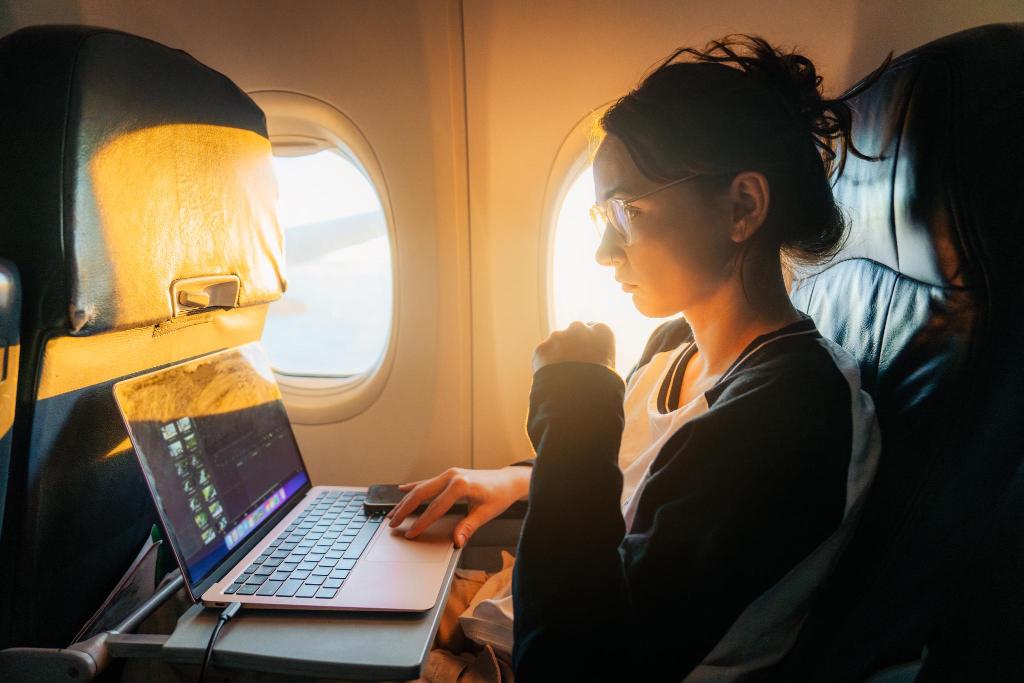
Do phones really need to be in airplane mode?
Yes, airlines require phones to be in airplane mode during flight. You can still use WiFi by enabling airplane mode and then turning WiFi back on separately.
Can you use mobile data on a plane?
No, mobile data should remain off during flight. Your phone wouldn't typically get reception at cruising altitude anyway. Instead, connect to the plane's WiFi system for internet access. Some airlines offer free messaging services through their WiFi system, even if you haven't purchased full internet access.
Does airplane WiFi cost money?
While some airlines offer free WiFi, most charge for the service. Prices vary by airline and flight duration. Some airlines have begun offering free WiFi to premium cabin passengers or as part of their loyalty programs. It's worth checking your airline's website before flying to look for any promotional offers or package deals.
Can you get WiFi on international flights?
Yes, many international flights offer WiFi through satellite-based systems. Coverage is generally available throughout the flight, though there might be brief interruptions when switching between satellite coverage areas. Some airlines partner with multiple providers to ensure more consistent coverage on long-haul routes.
Whether you're traveling for business or pleasure, staying connected in the air is becoming increasingly accessible. The technology continues to improve, with airlines investing heavily in better WiFi systems and more comprehensive coverage. Remember to check your specific airline's WiFi availability and pricing before your flight to ensure you're prepared for your journey.

- Sustainability
- Travel policies
- Wellness
- Accessibility
- Flight tips
 Flying to Alaska: The Complete Guide for TravelersApril 2, 2025
Flying to Alaska: The Complete Guide for TravelersApril 2, 2025 How To Navigate Customs and ImmigrationMarch 28, 2025
How To Navigate Customs and ImmigrationMarch 28, 2025 Making US Airports Manageable for Neurodivergent TravelMarch 28, 2025
Making US Airports Manageable for Neurodivergent TravelMarch 28, 2025 The 10 Best Airports for LayoversMarch 28, 2025
The 10 Best Airports for LayoversMarch 28, 2025 The Complete Guide to Flying Premium EconomyMarch 28, 2025
The Complete Guide to Flying Premium EconomyMarch 28, 2025 The Ultimate Packing List for VacationsMarch 28, 2025
The Ultimate Packing List for VacationsMarch 28, 2025 What are the Best US Airports for Flight ConnectionsMarch 18, 2025
What are the Best US Airports for Flight ConnectionsMarch 18, 2025 Which Times of Year are the Busiest for Air Travel in the US?November 7, 2024
Which Times of Year are the Busiest for Air Travel in the US?November 7, 2024 Flying to Hawaii: the complete guide for travelersSeptember 12, 2024
Flying to Hawaii: the complete guide for travelersSeptember 12, 2024 What Is Global Entry, and How Does It Work?August 25, 2024
What Is Global Entry, and How Does It Work?August 25, 2024 Everything you need to know to book a flightJuly 24, 2024
Everything you need to know to book a flightJuly 24, 2024
You might also like these
Learn essential airplane etiquette with our guide to the dos and don'ts of flying. Master plane manners, armrest rules and more for a smooth journey.
Do you need a passport to fly to Alaska? Explore everything you need to know about flying to Alaska, including which airlines fly from the US and more.
Have spare $50,000 to burn? Here are the world’s most expensive plane tickets you can buy and a glimpse at what you get for your money.
Our travel experts share which airlines have incredible business-class seats and how they compare.
Stay productive with these expert business travel tips: maximize comfort, utilize onboard amenities, and optimize your travel time for efficiency.
Discover essential airplane hacks from seasoned travelers. Save time, money and stay comfortable with these expert tips for a smoother flight.



